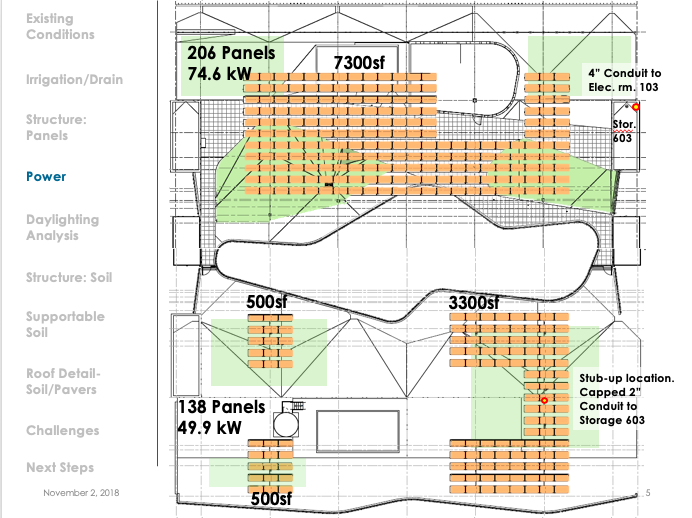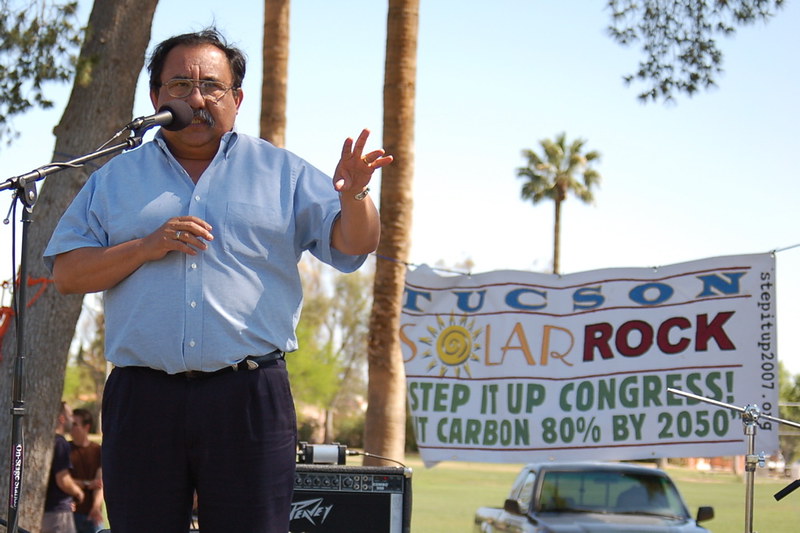Countries all over the world are attempting to come up with solutions to climate change and the lack of resources, energy and land to sustain the ever-growing population. One idea in particular, “agrivoltaics,” or “solar sharing,” has been around for a while but has recently grown in popularity.
The University of Arizona will be one of the first institutions in the world to have an agrivoltaics unit on top of a roof, combining two cutting-edge ideas — green roofs and solar sharing — into one, mutually beneficial unit.
Plans for an agrivoltaics array on the roof of the Environment and Natural Resources 2 Building were presented by the Office of Sustainability at a kick-off meeting Monday, Oct. 29, introducing the UA community to the planning, architectural design and funding for the project. The office said it hopes to move into construction this upcoming summer of 2019.
The kick-off meeting
The purpose of the meeting was to present what the Office of Sustainability has done so far and to present the framework of the project to the larger university community.
According to Trevor Ledbetter, the director of the Office of Sustainability, the meeting was a great point to start soliciting some new and different ideas that could be incorporated into the project.
Ledbetter said that his favorite part about the meeting was the level of interest that students expressed. “We had about half students, which was really great to see,” Ledbetter said. Many of them were students from Students for Sustainability, whose members played a key role in the project.
RELATED: UA Minute in History: ENR2
Stanley Wong, the SFS Energy and Climate Committee co-chair and a junior majoring in chemical engineering, was one of the students who spearheaded the project along with his co-chair Kelly McHugh, a junior majoring in environmental sciences.
“It really just stemmed from us recognizing that we wanted to see a change in how sustainability is conducted on our campus,” Wong said.
Students like Wong saw that there was not much on-campus, most of it being off-site. UA has 1.17 million kWh of photovoltaic electrical generation currently installed, and the ENR2 project will increase this by about 20 percent, according to Ledbetter.
Cutting-edge research
Greg Barron-Gafford is an associate professor in the School of Geography and Development who has been a driving leader in both the agrivoltaic research on campus and the engagement for this project.
Barron-Gafford works at the Biosphere 2 before, researching plants and ecosystems. He then went into geography and looked at applied physical science and its connection with people and food justice.
“That’s one of the things I like about geography: the human dimensions,” Barron-Gafford said.
According to Barron-Gafford, many countries have an issue with the lack of land for agriculture, buildings and solar panels. One possible solution is to place them all in the same area.
“We are, by far, way out on the front edge, because we’ve been doing this for a while out in Biosphere 2 with a couple of TUSD schools, so we have already worked through some of the challenges of it,” Barron-Gafford said.
Adding the green rooftops makes the plans even more cutting-edge. “I have never seen anyone doing both rooftop agriculture and rooftop photovoltaics,” Barron-Gafford said.
Climate change and ecosystem research
The project originally started because researchers like Barron-Gafford were looking at how ecosystems respond to different types of climate change.
Research in Tucson, a city located in the Southwest, focuses on ecosystems like grasslands, savannahs and deserts. Land use is changing, because more and more people are putting renewable energy into these areas, having an impact on the local environment.
According to Barron-Gafford, research has shown that large-scale solar panels can create a heat island effect, which essentially means that they give off heat, warming their surroundings. This turns into a practical question for people, because no one wants to live close to solar panels.
“That’s bad for a couple of reasons,” Barron-Gafford said. “One, it could influence people’s interest in having solar development, because they say that could influence our property values,” resulting in a barrier against moving towards using more renewable energy.
“The other part is that solar panels themselves are temperature sensitive,” Barron-Gafford said. “So, anytime a solar panel gets warmer than 77 degrees Fahrenheit, which is often here in the desert, it’s performing less efficient than it could.” Like with people, if it’s too warm for you, it’s probably too warm for the solar panel.
Some researchers thought about how they could cool down solar panels. Air conditioning takes up too much energy itself, but “plants are essentially like little evaporative coolers,” Barron-Gafford said. This creates a cooling effect on the ambient air.
Barron-Gafford and his research team tried putting plants underneath solar arrays to see if it would have the same cooling effect. They did independent studies and research with honors students at the Biosphere 2 and found that grass did cool the solar panels down but still left an issue with water usage.
“People need food; they need energy; they need water. How do you get all of those things without it negatively impacting the environment? Co-locating them is the solution,” Barron-Gafford said.
The UA Agrivoltaics Project at the Biosphere 2, led by Barron-Gafford, actually became a World Changing Ideas Awards finalist.
Building and funding
The main funding comes from the UA Institute of the Environment comes from Business Affairs under President Dr. Robert Robbin’s leadership, according to Ledbetter. As of now, $500,000 and $10,000 has been contributed according to Ledbetter. The total cost, with everything included, is estimated at $1.2 million. This presents a major problem with funding; however, they will most likely able to roll part or all of the rest of the cost into the on-campus, large-scale renewable energy costs, Ledbetter said.
According to Ledbetter, the green roof and other aspects will only cost around $300,000 to $400,000. The solar panels are the costliest aspect.
“There’s no shortage of ideas,” Barron-Gafford said. The funding is the real challenge.
On the other hand, the plans presented by Architecture and Design show how many solar panels can actually fit on the roof. “It was twice as much solar as I expected,” Ledbetter said. The estimated electrical production is 235,000 kWh per year, which is about a quarter of the electrical use for ENR2 each year.
President Robbins gave the go-ahead about two weeks ago to move into a request for proposals stage, which means the Office of Sustainability will create a plan and send it into the marketplace to garner competitive bids.
Community and student engagement
“It’s only thanks to the president plugging in resources to drive experiential learning and research in terms of environment and what’s going to be happening in the next century,” Barron-Gafford said. He said he wants to make sure that students are on the front end of solving the environmental challenges being brought to us by climate change.
Both Ledbetter and Barron-Gafford said that SFS has been the larger part of student engagement so far, but that hopefully there will be a lot more.
There are many opportunities for engagement, including community garden workshops and working with K-12 students.
“The more people you have, the more ideas are contributed to this overall project, and overall, I think it leads to a better project in the end,” Wong said.
If students are interested in engaging with the project, whether in the research, the site development or in independent studies, they should contact Office of Sustainability Director Trevor Ledbetter.
Follow Alana Minkler on Twitter









